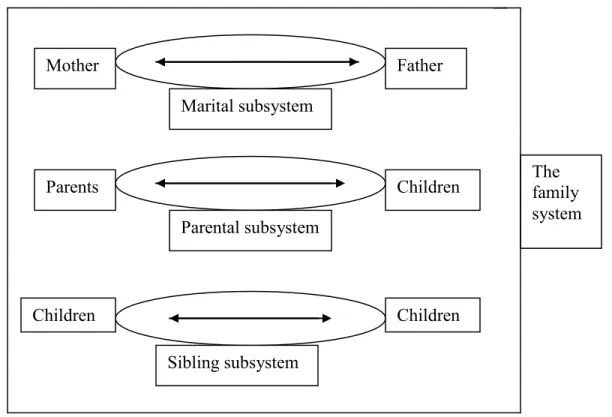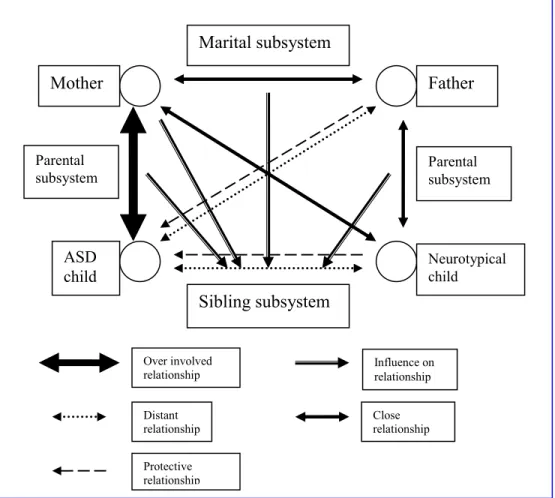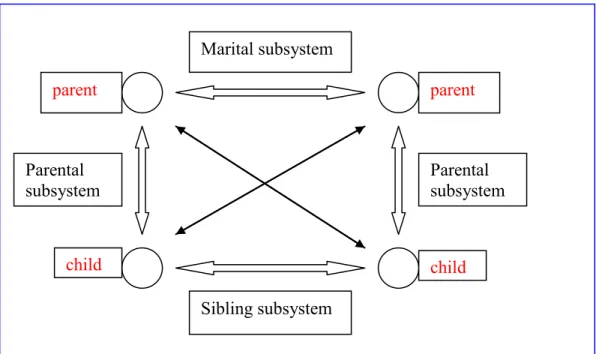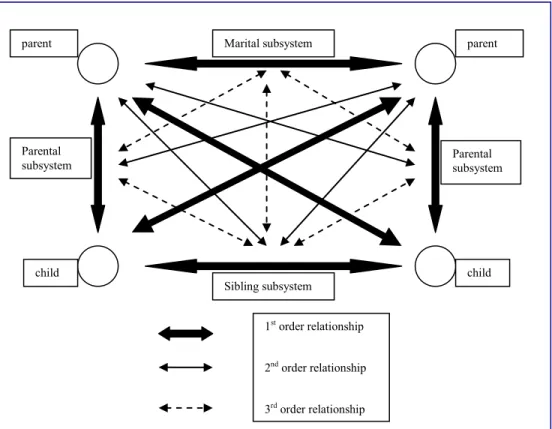Autism spectrum disorders have been shown to be some of the most disruptive and unusual childhood developmental disorders affecting all family relationships (Glass, 2001). Using family systems theory as a framework for understanding, the question posed in this study was, "What is the experience of having a sibling with autism spectrum disorder?" The study used a phenomenological approach that was useful in exploring the participant's “lived world”.
INTRODUCTION
- A IMS AND O BJECTIVES OF THIS STUDY
- Aims of the Study
- Objectives
- M ETHODOLOGICAL A PPROACH
- D EFINITION OF T ERMS
- O UTLINE OF THE STUDY
The first aim of the study was to explore the understanding and construction of sibling disorder among unaffected siblings. Finally, the study also sought to explore the family system perspective of unaffected siblings.
LITERATURE REVIEW
U NDERSTANDING A UTISTIC S PECTRUM D ISORDERS
- A Historical Perspective of Pervasive Developmental Disorders and Autism
- Diagnosis of Autistic Spectrum Disorders
- Etiology
- Treatment of Autistic Spectrum Disorders
Furthermore, this discovery led to the emergence of the idea of an "autistic spectrum," in which children exhibiting autistic traits are diagnosed along a continuum of functioning. Studies have shown that the increase in the incidence of ASD started when the MMR vaccine became widespread and that the onset of an ASD after 18 months correlates with the administration of the vaccine around the same age (Rimland, 2000).
F AMILIES OF C HILDREN WITH A UTISTIC S PECTRUM D ISORDERS
- Family Systems
- Challenges for the family
- The Sibling Relationship
- Siblings and Autistic Spectrum Disorders
Typically, one would expect that research would show that siblings of children with ASD are often disturbed in their behavior and that the quality of the relationship is negatively affected by having a sibling with ASD. The majority of studies have focused on quantitative comparisons between siblings of children with ASDs and siblings of normally developing children.

C ONCLUSION AND R ATIONALE
In general, there seems to be a debate about whether the development of the non-affected child and the sibling relationship is negatively or positively influenced by a sibling with ASD. In general, most research conducted has used a quantitative approach and does not provide a more in-depth understanding of the non-affected sibling's experience.
RESEARCH AIMS AND METHODOLOGY
- R ESEARCH Q UESTION AND A IMS
- R ESEARCH D ESIGN
- S AMPLING
- D ATA C OLLECTION
- The Interviews
- The Focus Group
- Participatory Techniques
- T HE R ESEARCH P ROCESS
- Informed Consent
- Interviews
- Focus group process
- Ethical Considerations
- D ATA A NALYSIS
- T RUSTWORTHINESS IN Q UALITATIVE R ESEARCH
Hermeneutics is, in essence, a method of understanding the world of participants and interpreting their meanings and practices through immersion in data (Hutchinson, 1991). This study used semi-structured individual interviews with each participant in order to gain a deeper understanding of participants' perspectives on having a sibling with ASD. The focus group took place in the home of one of the participants after all interviews had been conducted with individual participants.
The hermeneutic circle was the beginning of the analysis process, where the researcher delved into the data and clarified all the points where necessary. This process was accomplished by diving into the data and identifying the various themes and patterns that emerged. The researcher tries to tell the story of the data, including those that have not been told.
In this sense, triangulation refers to the use of multiple methods of data collection and analysis to eliminate bias and maximize the veracity of the results. William (2006) describes credibility as being related to the internal validity of data and interpretation.
RESULTS
T HE INTERVIEWS
- Common perceptions of ASD and their sibling
- Nature of the relationship
- Perceptions of the family system
- Social adjustment and coping
In Adam's case, he felt that the most important feature of his brother's ASD was the fact that he was unable to use verbal language to communicate. Adam felt that his brother could not understand him properly when he spoke to him. In this sense, the most prominent feature of the sibling relationship that emerged from the interviews was the fact that all participants felt protective or responsible towards their sibling in one way or another.
Remarkably, all the participants felt that their most frightening memory of their sibling was when something bad had happened to them. As a result, it was clear from the interviews that the participants all felt responsible for their siblings. The interviews also provided information about the types of activities the participants did with their siblings.
In one way or another, the participants expressed that their mothers felt the most stressed and angry with or towards their siblings. Regarding participants' perceptions of their fathers' feelings and roles in the family, both Adam and Kim stated that their fathers were not as stressed as their mothers and did not get as angry.
T HE FOCUS GROUP
- Common Perceptions of ASD and their sibling
- Nature of the relationship
- Perceptions of the family system
- Social adjustment and coping
In discussing this difficult behavior, participants again talked about their siblings often taking their things. Furthermore, both Kim and Paul described incidents of their siblings getting lost, and the sentence completion exercise highlighted the fact that participants were emotionally affected by this behavior. All participants indicated on the sentence completion exercise that family activities evoked positive feelings in them, while the discussion revealed that such activities were often difficult.
Both the informal discussion during the focus group and the sentence completion exercise provided additional information about the participants' perception of their parents' role in the family. In terms of social adjustment and coping, the interviews and sentence completion exercise highlighted that the participants were very busy socially and involved in sports. The sentence completion exercise also revealed that the participants most enjoyed excursions and getting away from home.
All the participants indicated in both the informal discussion and the sentence completion exercise that they were happiest when the family could do things together, or when things went smoothly. No further elaboration on the participants' social activities or coping skills was elicited during the focus group.
C ONCLUSION
DISCUSSION
- C OMMON PERCEPTIONS OF ASD AND THEIR SIBLING
- T HE N ATURE OF THE S IBLING R ELATIONSHIP WITH AN ASD C HILD
- S OCIAL A DJUSTMENT AND C OPING
- T HE F AMILY S YSTEM
- T HE E XPERIENCE OF H AVING A S IBLING WITH AN ASD
A variety of challenging behaviors were also described by participants as features of their siblings' presentation. It can also be seen that such difficult behavior gives rise to the negative feelings expressed by the participants. Results showed that participants often felt disappointed, frustrated, or angry about their sibling and the situations created or prohibited by their sibling's ASD.
Whether this has been illustrated by the experiences of the participants in this study is debatable. The experiences of the participants in this study do not seem to include excessive levels of The experience of these areas of impairment also appeared to affect the relationship between the participants and their siblings.
The participants gave voice to feelings of frustration, anger, anxiety and embarrassment towards their siblings”. As a result of their sibling's inappropriate behavior, participants also expressed feelings of embarrassment.

CONCLUSIONS AND RECOMMENDATIONS FOR
C ONCLUSIONS ABOUT THE FINDINGS
The researcher expected that participants' experiences would be more negative when faced with a wider variety of problematic behaviors, routines, and distractions. It also illustrates that the more intimate the sibling relationship, the more difficult it becomes for the unaffected sibling to tolerate the disruptive, bizarre, and problematic behavior of their ADDI sibling. In addition, the study confirmed that aspects such as developmental stage and gender can influence the experience of having a sibling with ADHD.
Significantly, the study also showed that participants were coping well with ASD in their homes and lives. The researcher had a preconception that the participants would show difficulties in the areas of school, friendships or social adjustment. This study challenged that assumption, illustrating that participants were socially autonomous and used busy schedules to cope with the difficult situation at home.
Overall, the participants were found to be friendly, well-adjusted and coping with having a sibling with an ASD. While their relationship with the sibling is often difficult and frustrating, they have learned to use their environment as a protective factor against the different experience of having a sibling with an ASD.
S TRENGTHS AND L IMITATIONS
Obtaining safety information from their parents may have provided information about their adjustment and coping skills that participants were unable to reflect on. The selection of participants in this study may have its limitations as all the participants came from financially stable families. Similarly, the additional mural activities in which participants participated would not be affordable for all families in all socioeconomic status groups.
Consequently, the level of coping and adjustment displayed by the participants in this study is not generalizable to all siblings of children with ASD. In the same way, the participants of this study were all the older of the two, where having the younger sibling also has an effect on the experience of a sibling with ASD. Considering the participants' ages and concentration span, the duration of the focus group may have been too long.
In this sense, the results may have been biased as more focus was placed on those aspects that were difficult for the relationship and much less focus on positive aspects for the participants' siblings. Had there also been an exercise on the positive attributions of their siblings, participants could have been given an opportunity to indicate that the experience of having a sibling with ASD is less difficult than illustrated here.
R ECOMMENDATIONS FOR F UTURE R ESEARCH AND P RACTICE
Each participant will be asked to draw a picture of their family where each family member is doing something. The purpose of the study will be to highlight the different ways in which children perceive the experience and cope with having a sibling with an autism spectrum disorder. The results of the study will be published in the form of a thesis in the School of Psychology at UKZN.
I will conduct two interviews with your child and ask him/her to participate in a focus group. The purpose of the study has been explained to me and I understand what is expected of my child's participation. I hereby consent to the audio recording of the interviews and focus group for the purposes of data capture.
I'm going to ask quite a few questions about you and your family and the kinds of things you like and don't like. I want to ask a lot of questions about how you get along with your brother or sister.

